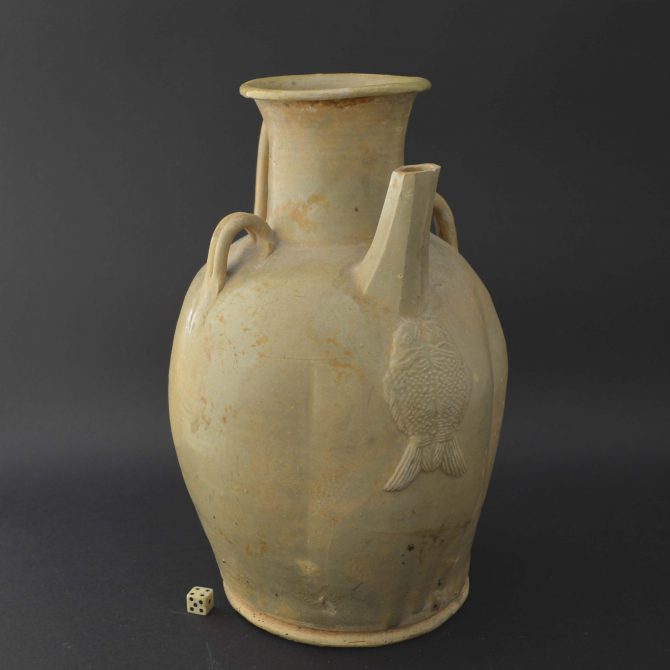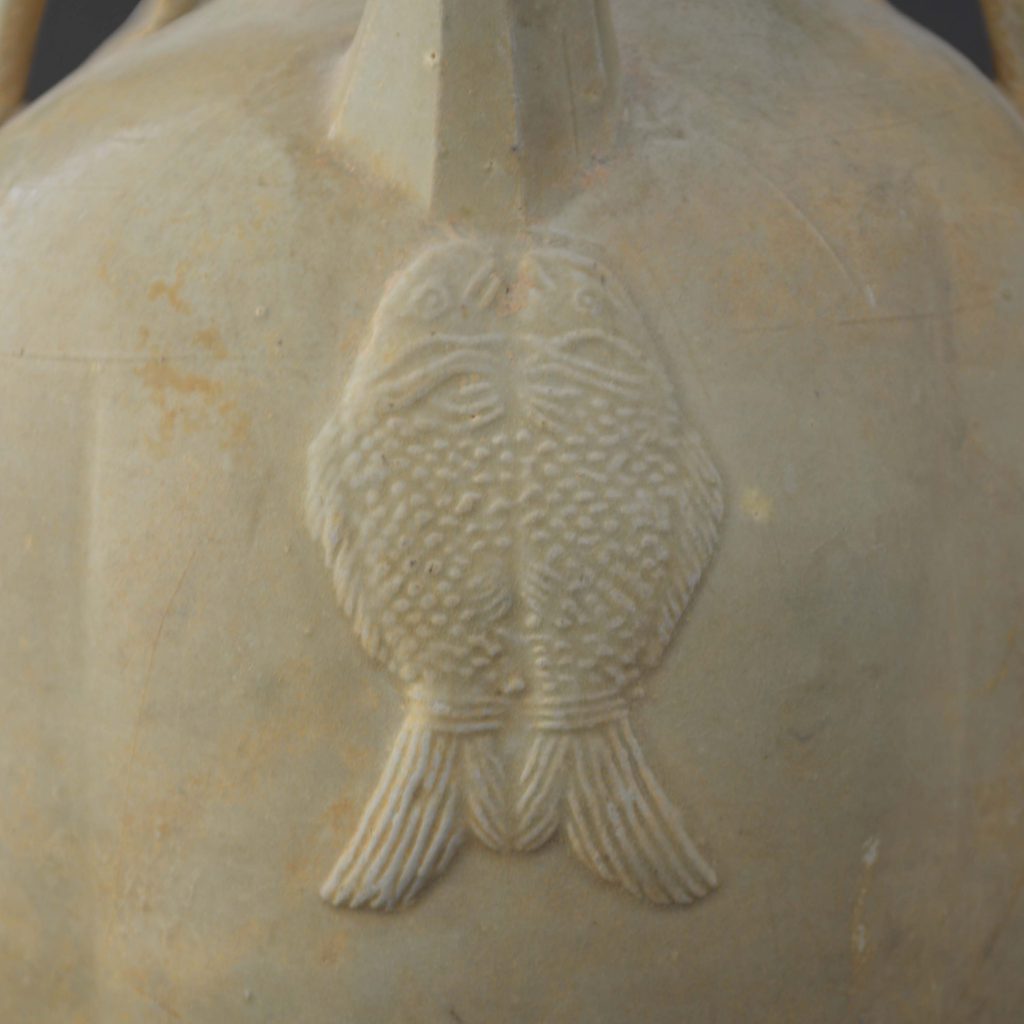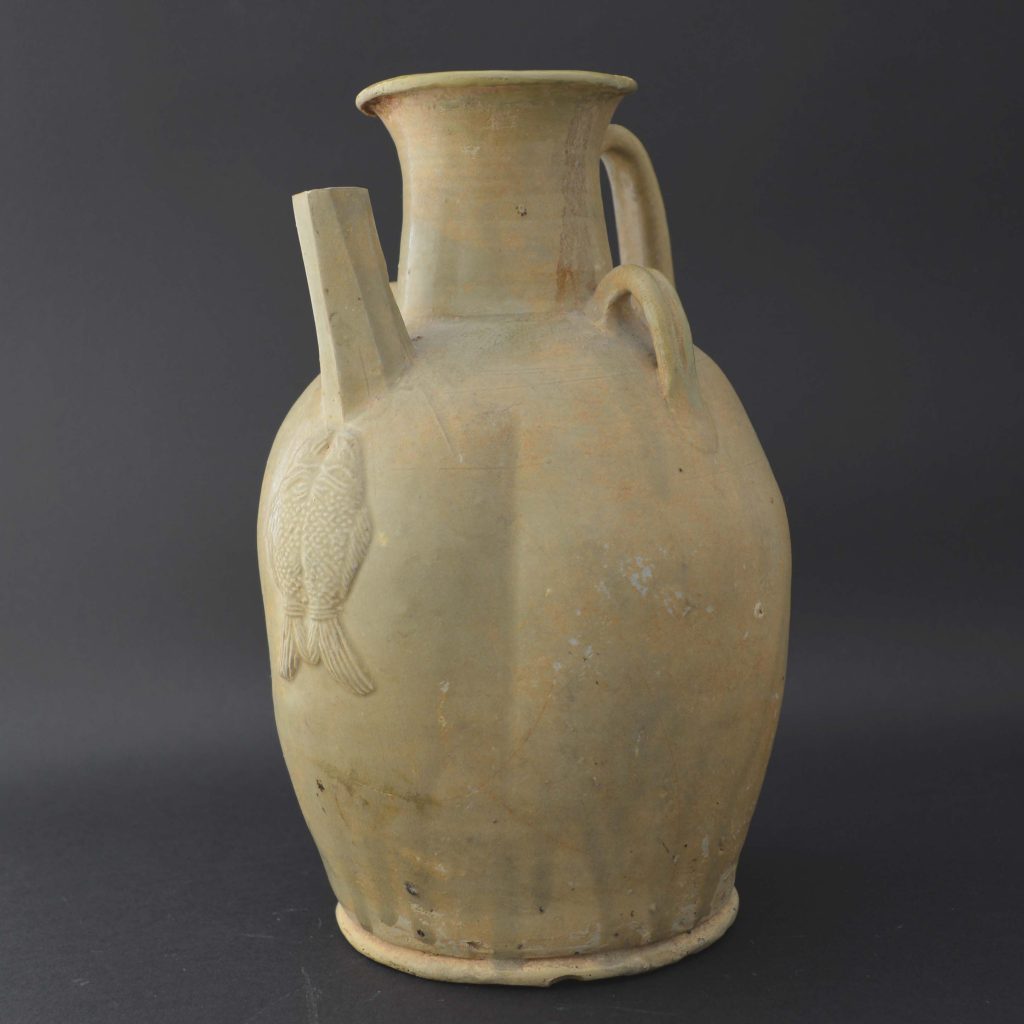
A Tang Dynasty Changsha Ewer 9th Century.
A Tang dynasty Changsha ware from the Changsha kilns in the central southern province of Hunan, 9th century. Below the spot is a ‘twin fish’ applied motif.
SOLD
- Condition
- In very poor condition, with crude repairs ; the front beneath the twin fish has a very large star shaped crack with cracks running off it. There is a large repaired chip to the top rim and shallow chips repaired, the handles have the top surface repaired. Small glaze flakes painted over.
- Size
- Height : 22.8 cm (9 inches)
- Provenance
- An antique shop in Marlborough 24th June 1998. NICOLAS THOMPSON COLLECTION : Nicholas de la Mare Thompson (1928-2010), the grandson of the author Walter de la Mare spent his career in publishing. He started at Nesbit where he was editor of the Janet and John series of children’s books but not all of his career was so safe. He wrestled with W.H. Smith over the content of Madonna’s raunchy Sex book on behalf of Paul Hamlyn’s Octopus Group and defeated Margaret Thatcher over Spycatcher. He could not bare dogma or hypocrisy. It was hardly surprising that as a committee member of the O.C.S. he had his own ideas. He read and could recite great swaths of the articles of the Society, he used this not to attack but to stimulate debate. He approached the Society in the same way as he approached his understanding of Chinese ceramics, by stripping it down and starting again using clear empirical thinking. He was very concerned the Society was open to all and was run for the benefit of all members. Nicholas came from a family of collectors, his love of oriental ceramics was broad but his focus was on early monochromes, especially those from the Song dynasty. He bought what he loved, what he thought had merit, not what was said to be good, and certainly not anything because it was fashionable. He didn’t have a stamp collectors approach, filling in the gaps of pre-existing ordered collection, rather he would react to an object, feeling it was right for his collection. Sometimes he wasn’t sure if it was right for his collection or not. He would then “borrow” pieces and live with them, other times he would ask his wife Caroline, who’s eye he trusted, if he should keep the piece or not. He was amused because I was often able to know if he would keep a piece before he did. We discussed “pots” endlessly, he loved to talk about ceramics with a wide variety of people, and enjoyed the company of others on O.C.S. trips as well as in discussion groups or anywhere else. Later on he combined his love of Chinese ceramics with his love of books by extending his library to include rare early books, he used these to trace the development of collecting and scholarship in the 19th and early 20th century. He was fascinated by earlier scholarship, what was not understood but also what they understood and we have lost. He was always reading and wanted to know more right up to the end, he didn’t see impending death as a barrier to knowledge or indeed collecting. The week before he died he questioned, if only for a second, whether it was too late to buy another pot for the collection. He concluded it was not, he was a true collector. Nicolas died on the 25th of April 2010 at the age of 82 after living with cancer for two years. He leaves behind his energetically supportive wife Caroline and his three children. He was a kind, gentle and incredibly civilised man with a very sharp mind and dry sense of humour, he was passionate about the Society, its aims and its members. He was an incredibly supportive and thoughtful friend and is very much missed .
- Stock number
- 24874
- References
- For a group of Tang Changsha ewers of this type but with iron-oxide splashes see : Shipwrecked, Tang Treasures and Monsoon Winds (Edited by Regina Krahl, John Guy, J. Keith Wilson and Julian Raby. Smithsonian Institution 2010. ISBN 978-0-934686-18-1) illustrated on pages 58-59, fig.49
Information
Belitung shipwreck :
The Belitung shipwreck (also known as the Tang or Batu Hitam Shipwreck). Another bowl from the Belitung shipwreck is inscribed with a date equivalent to 826, a carbon 14 analysis of the wreck also confirms a Tang date (618 - 907).
The Belitung shipwreck was found by fishermen off the Indonesian Island of Belitung in 1998. The German group, Seabed Explorations, purchased the location from the fishermen and began excavation under license in the latter part of the same year. It seems that the Belitung shipwreck is the only example of an ancient Arab ship ever found. The extensive hull remains were stitched together. Its location in Indonesian waters, and its cargo of Chinese ceramics, provide archaeological evidence for direct trade between the Western Indian Ocean and China in the first millennium, although this is subject to some speculation.
Fish / Yu :
The Chinese word for fish `Yu` is pronounced in the same way as the word for abundance. So fish have come to represent prosperity and the carp is often represented as sign of success because of its perseverance, swimming up river. Pairs of fish swimming together, representing marital bliss, were common from the Southern Song (1128-1279) but it was in the Yuan Dynasty (1279-1368) that fish swimming with aquatic plants became a common subject, the patterns were based on popular designs found in Southern China. Some of the earliest Chinese blue and white porcelain (c.1320-1350) depicts fish swimming with plants, frequently lotus as this represented purity. These Yuan designs were shown in the center of bowls and dishes surrounded by concentric geometric borders.It was not until the 16th century that freer, more open designs of fish swimming among sea weed and crabs were popular.





